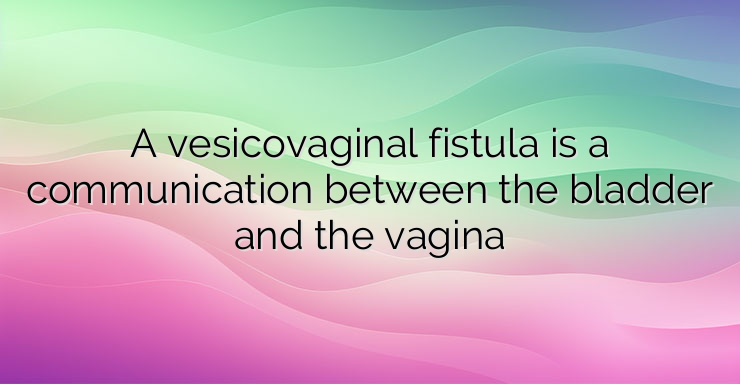A vesicovaginal fistula is an abnormal connection (communication) between the bladder and the vagina that allows urine to flow continuously through the vagina. Vesicovaginal fistulas are a common complication of normal childbirth in the developing world because of the length of the labor process. This causes pressure on the pelvic floor and tissue necrosis of the posterior wall of the bladder and/or urethra. This variant of fistulization is also called an obstetric fistula. Some operative techniques related to childbirth can be complicated by the formation of a vesicovaginal or vesicorectal fistula. These include the application of forceps, which can sometimes be particularly traumatic, abdominal C-sections or symphysotomies. Other reasons for the occurrence of vesicovaginal fistulas can be spontaneous ruptures of the bladder, trauma, inflammatory processes. Bladder ruptures are spontaneous and violent, penetrating and incomplete. In principle, it is believed that an empty bladder can never rupture on its own, as this requires a certain hydrostatic pressure exerted by the urine in it. The areas of the upper and back wall of the bladder, where the musculature is the least developed, are most often torn. Endovesical factors favoring the rupture of the bladder wall and fistula formation are various benign and malignant formations in the bladder, inflammation, age-related atrophy, diverticula and concretions in the bladder, pericystitis. Bladder injuries that may lead to rupture are open and closed. Closed injuries are caused by blows to the abdominal area, falls and rarely when lifting heavy weights. Rupture of the bladder in these cases is possible only if it is overfilled. Overt injuries are often the result of gunshot injuries, transport and work accidents. Surgical injuries to the bladder and the distal part of the ureters during pelvic floor surgery are relatively common. This is explained by the expansion of the volume of surgical interventions, mainly in oncological gynecological operations. Oncological urological fistulas are understood as pathological connections between the urinary system and the reproductive system as a result of spontaneous tumor growth of the vesicovaginal septum. Bladder injury is sometimes recognized during the initial operation, but in some cases the fistula develops later. The main complaint of patients with vesicovaginal fistula is partial or complete urinary retention, both at rest and in motion. In some patients, a lack of appetite, insomnia and flu-like complaints are observed. Patients experience significant emotional stress from continuous urination. With copious leakage of urine through the vagina, its mucous membrane and external genital organs are moist, red and swollen. The normal acidic titer of the vaginal discharge during fistulization is disturbed and becomes alkaline,due to neutralization of lactic acid from alkaline urine. Infected urine and the presence of diverse bacterial flora contribute to the occurrence and maintenance of already existing vulvovaginitis. Patients are extremely often diagnosed with recurrent cystitis and cystopielitis. In patients with picochopolous fistulas, a more abundant precipitation of salts is observed in the distal part of the picochopolous system. In some patients, urinary salts and stones appear already in the first days after fistula formation. The success of the treatment of patients with vesicovaginal fistulas depends on the precision of the tests and the correct diagnosis. In addition to the exact medical examination, a number of instrumental tests are used to make the diagnosis. Urethrocystoscopy allows the correct evaluation and localization of the fistula. Excretory urography is mandatory in all patients with urogenital fistulas. Spontaneous healing of vesicovaginal fistulas is rare and is more typical of obstetric postpartum injuries. In these cases, placement of a urethral catheter is recommended, which remains for a longer period of time, sometimes 2-3 months, until the fistula opening is completely healed. Fistulas resulting from cancer, long-standing fistulas and those located in the area of the urethrotrigonal sphincter rarely heal spontaneously and require surgical treatment. Surgical treatment is carried out for fistulas formed during childbirth and traumatic fistulas. Fistulas are not operated in oncological diseases, after radiation therapy and in some specific inflammations of the bladder, such as Lues and tuberculosis. References: Urology, Prof. P. Panchev https://www-londonurologyspecialists-co-uk./vesico-vaginal-fistulathose of long standing and those located in the area of the urethrotrigonal sphincter rarely heal spontaneously and require surgical treatment. Surgical treatment is carried out for fistulas formed during childbirth and traumatic fistulas. Fistulas are not operated in oncological diseases, after radiotherapy and in certain specific inflammations of the bladder, such as Lues and tuberculosis. References: Urology, Prof. P. Panchev https://www-londonurologyspecialists-co-uk./vesico-vaginal-fistulathose of long standing and those located in the area of the urethrotrigonal sphincter rarely heal spontaneously and require surgical treatment. Surgical treatment is carried out for fistulas formed during childbirth and traumatic fistulas. Fistulas are not operated in oncological diseases, after radiotherapy and in certain specific inflammations of the bladder, such as Lues and tuberculosis. References: Urology, Prof. P. Panchev https://www-londonurologyspecialists-co-uk./vesico-vaginal-fistula


Leave a Reply